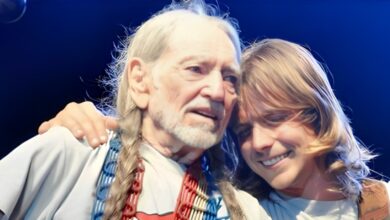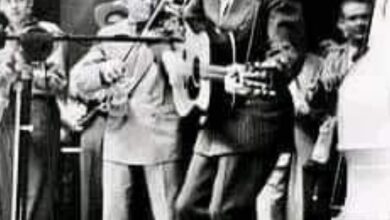SSG Barry Sadler’s Patriotic Hit – “The Ballad of the Green Berets” (1966)
In 1966, Staff Sergeant Barry Sadler released “The Ballad of the Green Berets,” a song that quickly captured the national sentiment during the tumultuous years of the Vietnam War. This patriotic ballad, celebrating the courage and sacrifice of the U.S. Army Special Forces, known as the Green Berets, resonated deeply with American audiences. Written during Sadler’s recovery from a leg injury sustained in Vietnam, the song’s impact was immediate and profound. It soared to No. 1 on the Billboard Hot 100, where it remained for five weeks, distinguishing itself as one of the year’s standout singles alongside the likes of The Beatles and The Rolling Stones.
Barry Sadler, a Green Beret medic who served in Vietnam, drew directly from his military experiences to craft the lyrics of this influential song. His firsthand knowledge of the hardships and heroism faced by the Special Forces added a level of authenticity that contributed to the song’s success. The ballad not only celebrated the valor of the Green Berets but also tapped into the broader American sense of patriotism during a period marked by widespread division and conflict over the Vietnam War.
The success of “The Ballad of the Green Berets” marked a turning point in Sadler’s life. The acclaim from the song led to his discharge from active duty and opened the door to a new career in music. However, despite his early success, Sadler struggled to maintain the same level of popularity with his subsequent musical releases. None of his later songs managed to achieve the same chart-topping success, and his career in music saw a steady decline after his initial breakthrough.
Sadler’s early fame from the song provided opportunities for high-profile appearances, such as on The Ed Sullivan Show, where he was able to showcase his hit song to a national audience. Despite these early opportunities, Sadler’s post-music career was marked by a series of ventures that failed to capture significant public or critical interest. His attempts at acting, business, and writing did not yield the same level of success as his music career had.
In the late 1970s, Sadler began to explore a new career path as a writer. He started a series of pulp fiction novels featuring Casca Rufio Longinus, a Roman soldier cursed to live until the Second Coming. Although these books did not achieve critical acclaim, they garnered a dedicated readership and helped to solidify Sadler’s reputation as an author. The Casca series continued beyond Sadler’s death, with contributions from other writers maintaining the legacy of his creation.
The trajectory of Sadler’s life took a darker turn in the late 1970s when he became embroiled in a serious legal issue. In 1978, Sadler was involved in the fatal shooting of country music songwriter Lee Emerson Bellamy. Sadler was convicted of voluntary manslaughter and served a reduced sentence. This incident significantly impacted his life, overshadowing his earlier achievements and contributing to a troubled period in his personal and professional life.
Following the legal troubles, Sadler moved to Guatemala in the 1980s. There, he continued to write and reportedly engaged in providing medical care to local communities amidst the ongoing civil war. His time in Guatemala reflected a return to his roots as a medic and his continued commitment to service, despite the personal and legal difficulties he faced.
Tragically, Sadler’s life ended abruptly when he was shot in the head during a suspected robbery in 1988. He was flown back to the United States, where he remained in a coma until his death. This final chapter in his life marked a somber end to a figure whose early success had made a significant impact on American popular culture.
Barry Sadler’s legacy is a complex one, marked by both extraordinary success and profound personal struggles. His enduring hit, “The Ballad of the Green Berets,” remains a poignant reminder of his contributions to music and patriotism, while his later years highlight the challenges he faced in his personal life. The contrast between his early fame and later difficulties underscores the unpredictable nature of public life and the ways in which personal and professional achievements can intersect and diverge.





